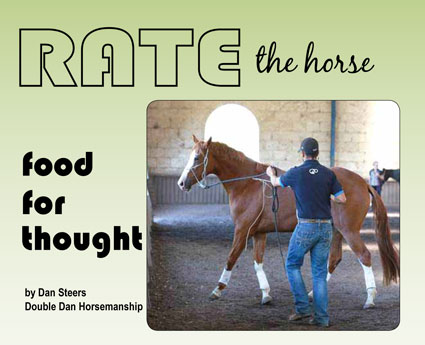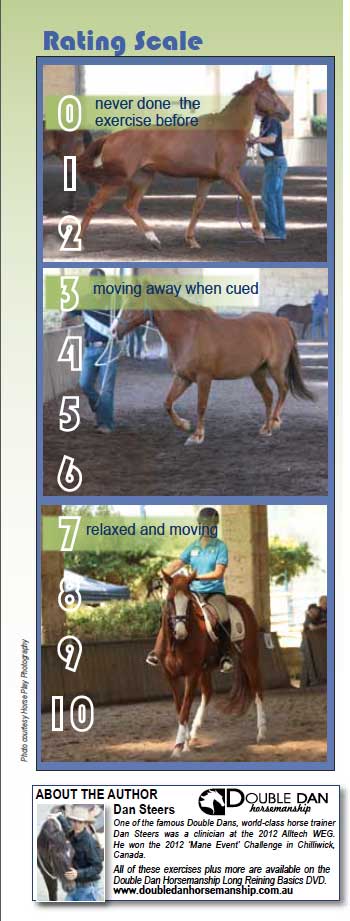 |
|

“Something I have started to use more recently in clinics is to ask the handlers/students to rate their horse from 0 to 10 as they work on a new or existing manoeuvre or exercise, which they are training their horse to do.
If I were to teach a horse to side pass down the fence I would rate them a 0 if they have never done the manoeuvre before, and a 10 would be my perfect horse, performing a soft, responsive, correct sidepass. As I start I would gauge the horse a 1 if they were thinking about the movement, at this stage I would stop and reward the horse by rubbing it. From here the horse should start to move down the fence and initially the rating would be a 2 or 3. Then again I would stop asking and reward him.
|
 CONTINUE TO REPEAT THIS EXERCISE by asking the horse to improve a little bit each time the exercise is CONTINUE TO REPEAT THIS EXERCISE by asking the horse to improve a little bit each time the exercise is
done and always be mindful not to push the horse beyond its current capabilities. If the horse was to start at a 0 and advance to a 5 in one lesson then I would be very happy with that. This would mean it is half way to being perfect in that manoeuvre, and in theory it would be perfect in two lessons, although the rate of improvement slows as they near perfection.
Of course, the advancement of the horse in most exercises is relevant to the persons experience, the horse’s level of trainability and the exercise itself, so don’t expect a 5 rating in every situation or with every horse in your first few training sessions.
So, when training the horse with this rating principle in place there are a couple of things that you need to keep in mind. Don’t try and jump the horse through the points, i.e. if it is a 4, then next time ask for a 5 rather than a 8 or a 9. This would be too much pressure for the horse and may risk causing frustration as it tries but doesn’t achieve the expectations so does not get rewarded. A way to know if you are going down the wrong track is if the horse is giving you an 8 then rapidly drops to a 2 or 3, as it would be telling you that it has been pushed passed where it is comfortable.
Another key point is, as the teacher you must be consistent when teaching. So before asking your horse to do something new you need to have a picture in your head of what a perfect 10 is. That picture should never change, for example today what is a 10 cannot tomorrow be your 6 then the next day be back to a 10. The horse will not be able to understand the inconsistency and in return will be inconsistent in the way it goes.
Now that the rating system is in place, you need to make sure that you reward your horse often as it moves through the points, and ensure that you don’t get too greedy and move it too quickly through the training.
And then everyone can achieve their perfect 10. "
TOPICS available online by Dr Jennifer Stewart
Vol 41 - 2
LYME DISEASE IN AUSTRALIA
Vol 41 - 1
I CAN HEAR SAND
Vol 40 - 6
LAMENESS
Vol 40 - 4
STRESS - how do we know if our horse is stressed?
Vol 30 - 1
STIFLE LOCK
with the Equine Veterinarians Australia (EVA)
Vol 27 - 4
ROSS RIVER VIRUS
Vol 36 - 6
BIOSECURITY
Vol 31 - 5
BIG HEAD
Vol 35-6
WHAT CONTROLS APPETITE IN HORSES?
Vol 35 - 4
BEHAVIOUR OR PMS
|